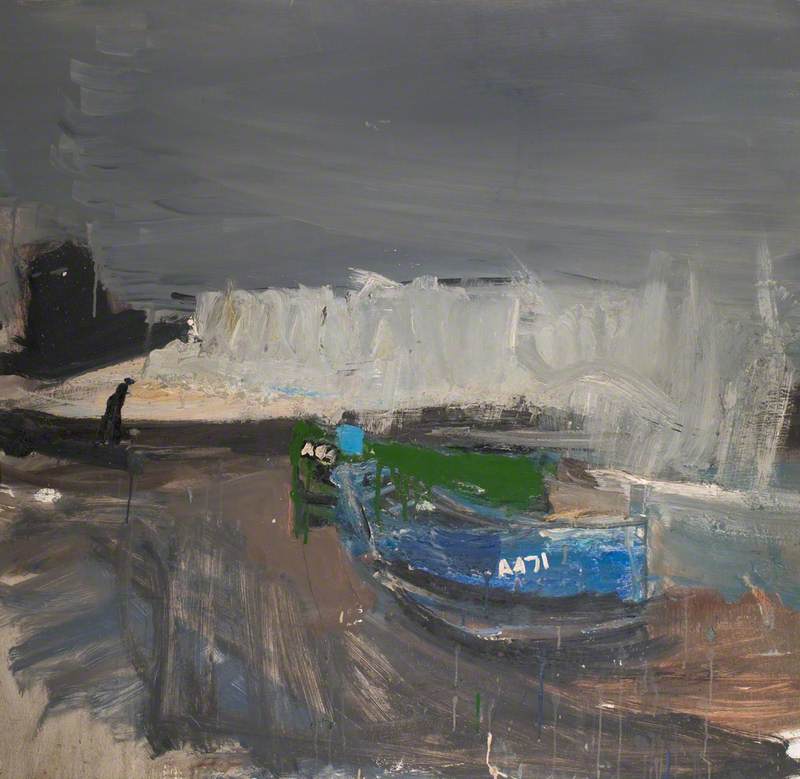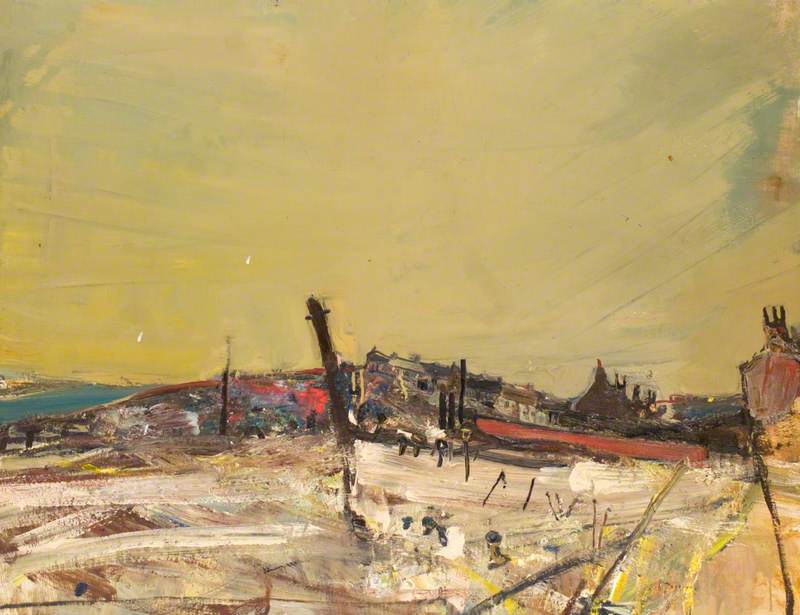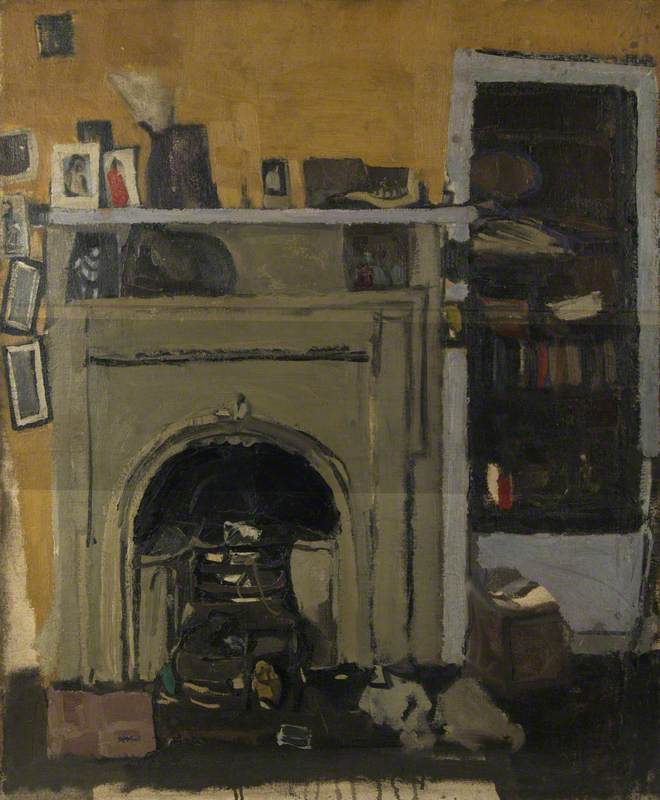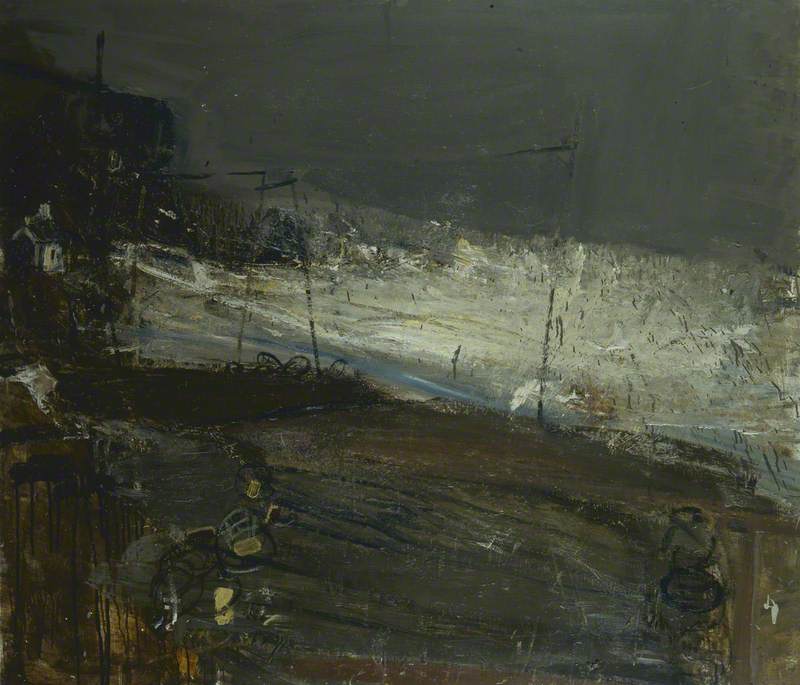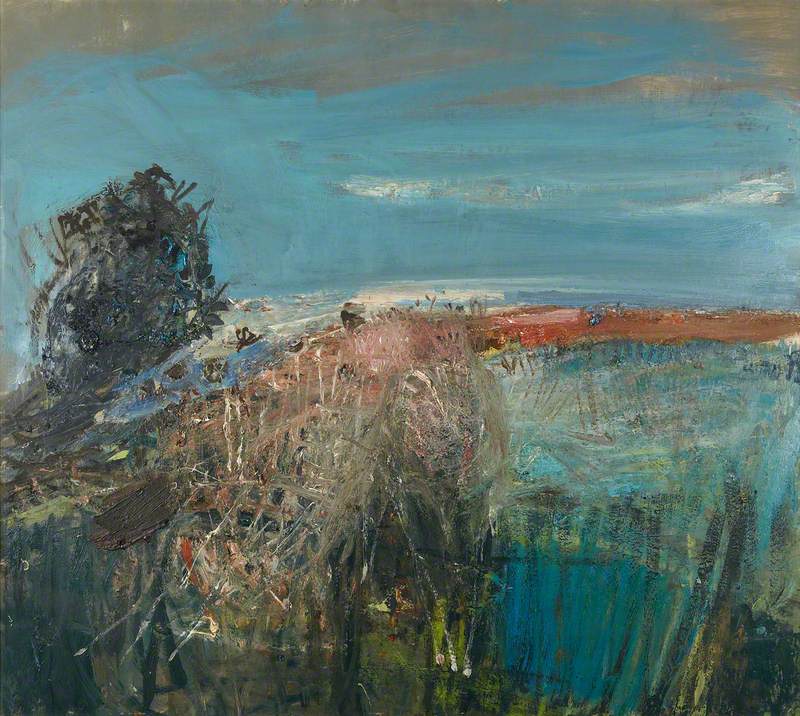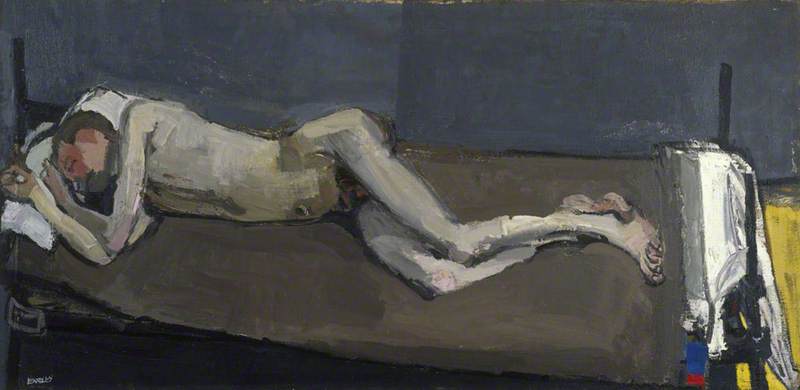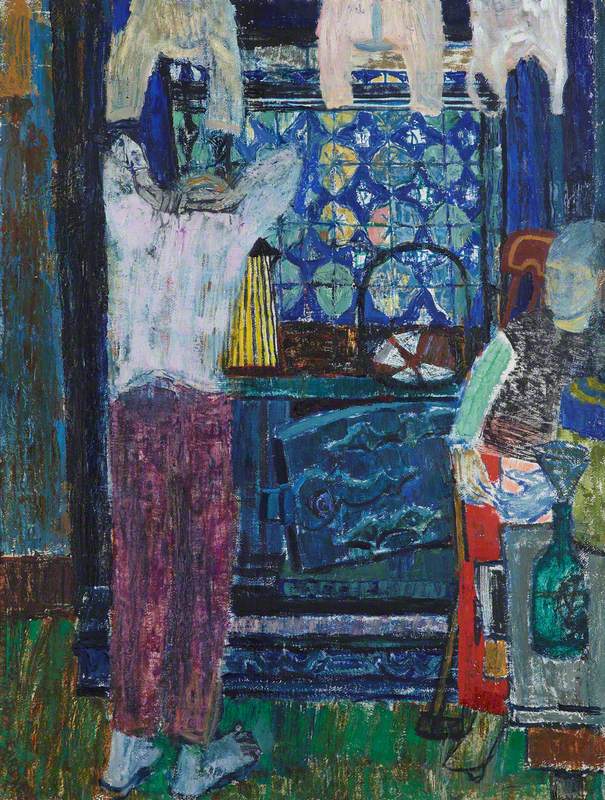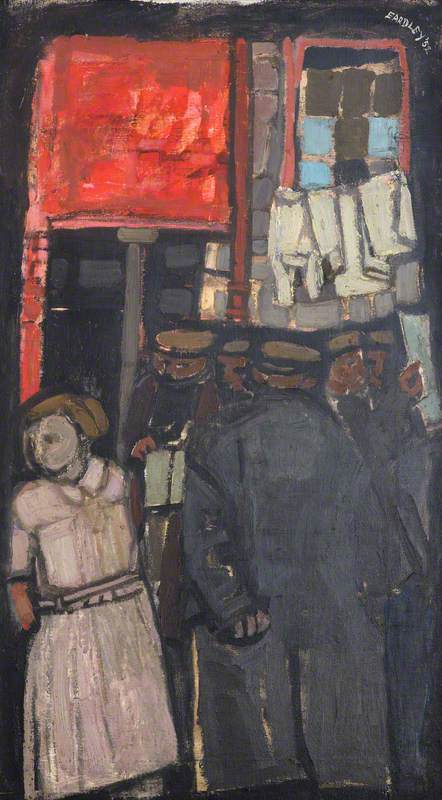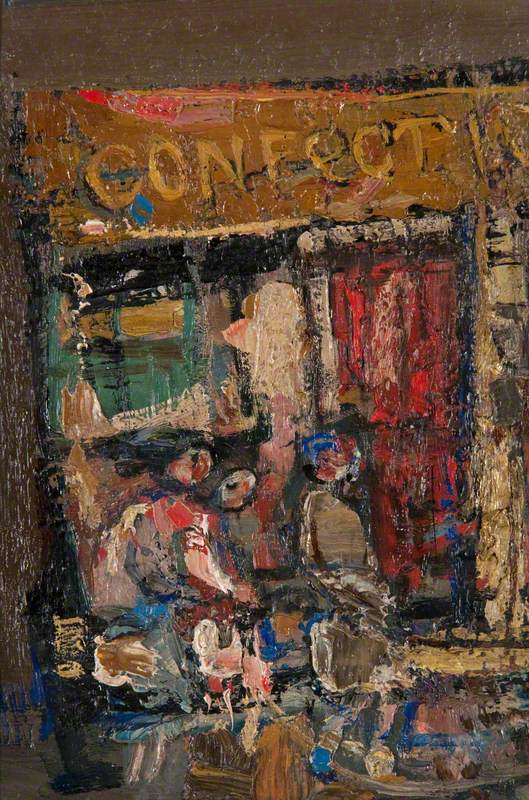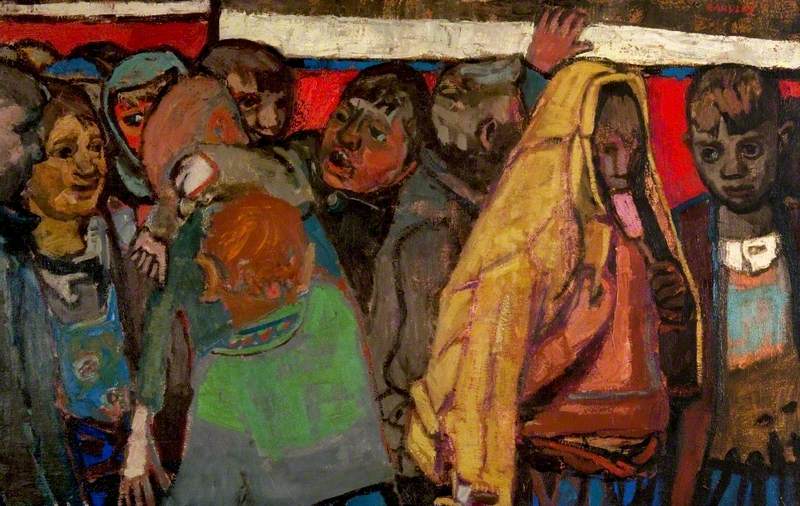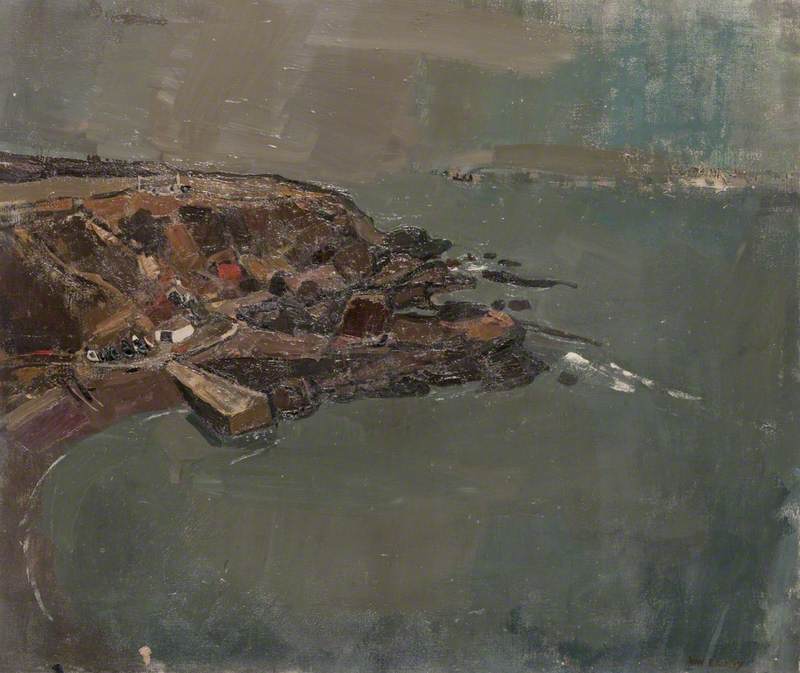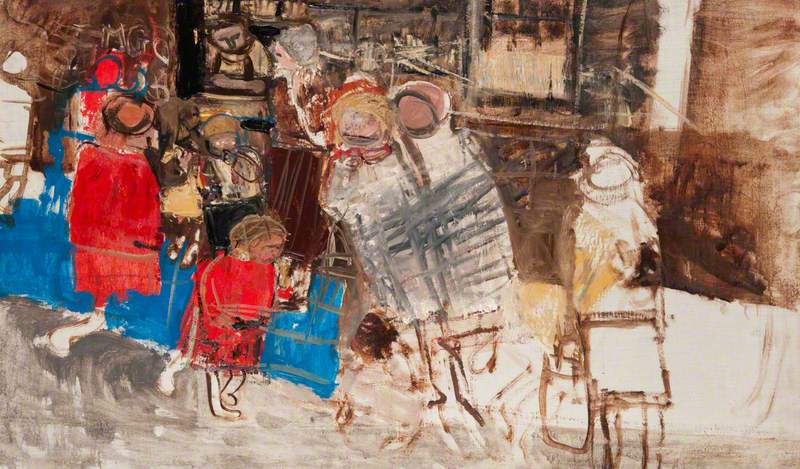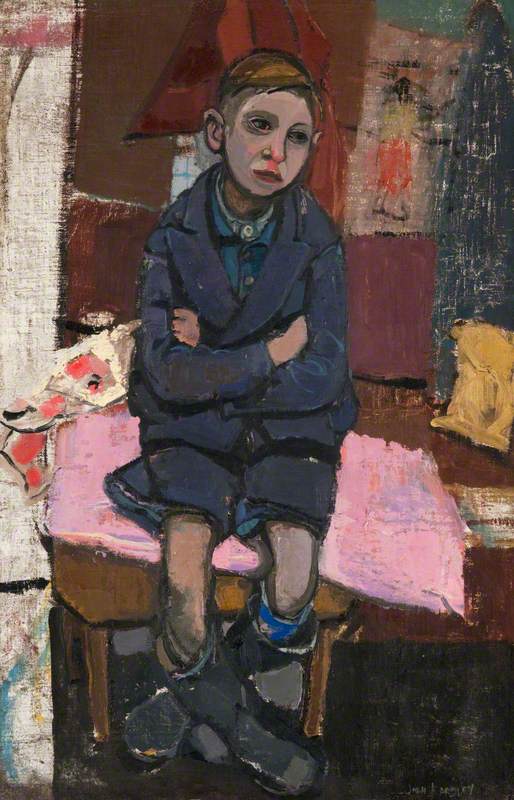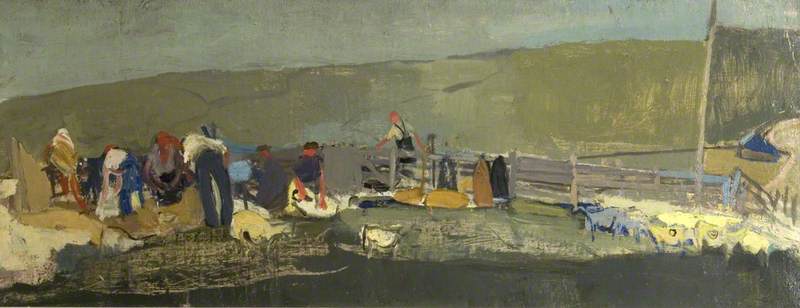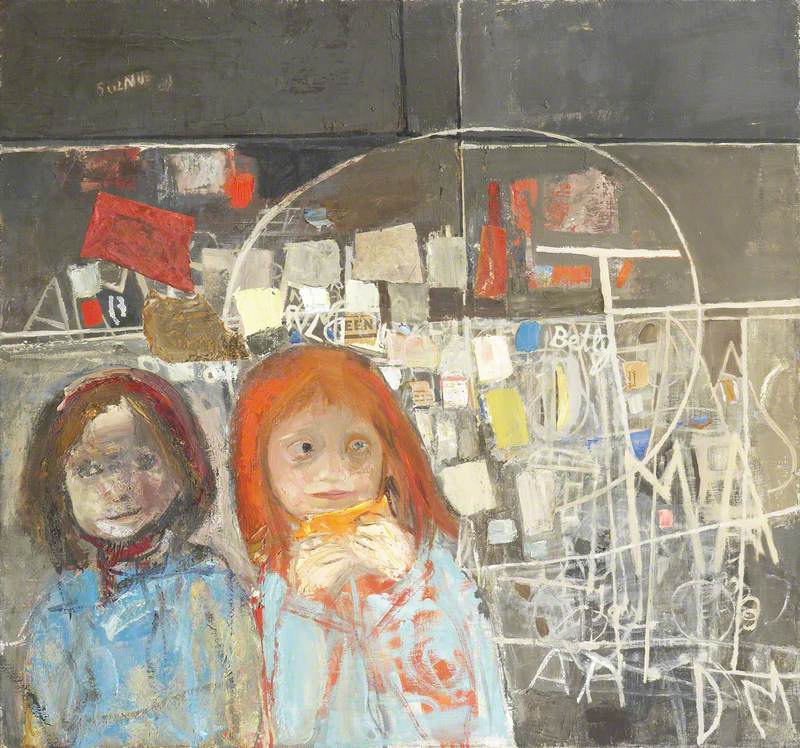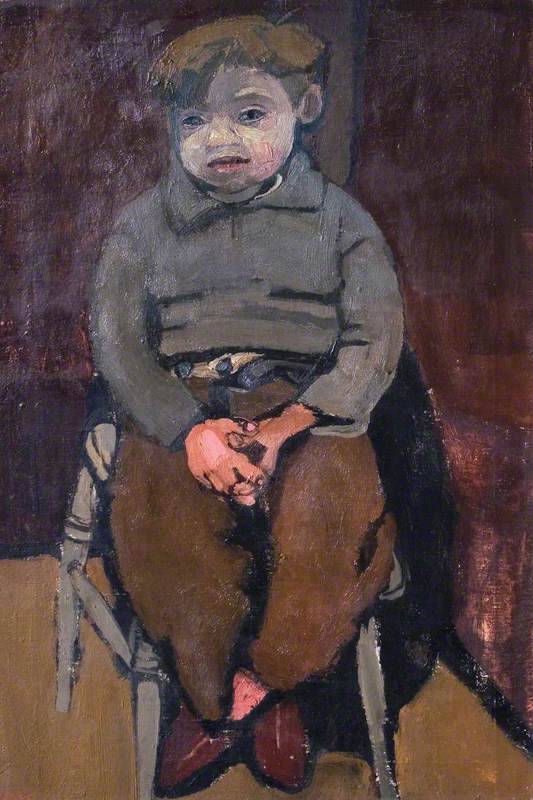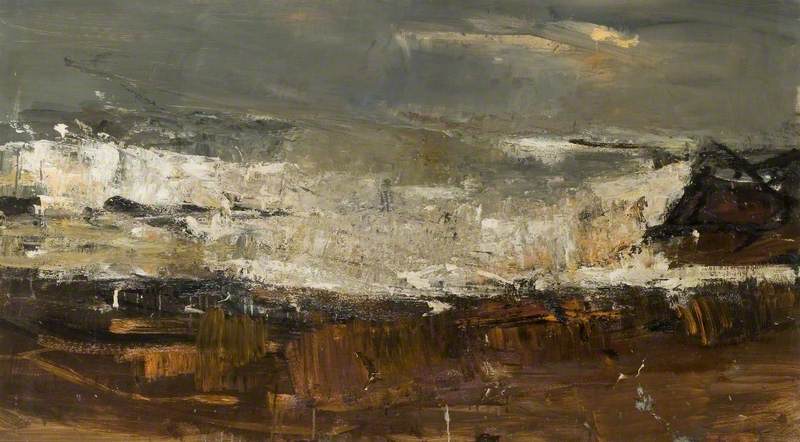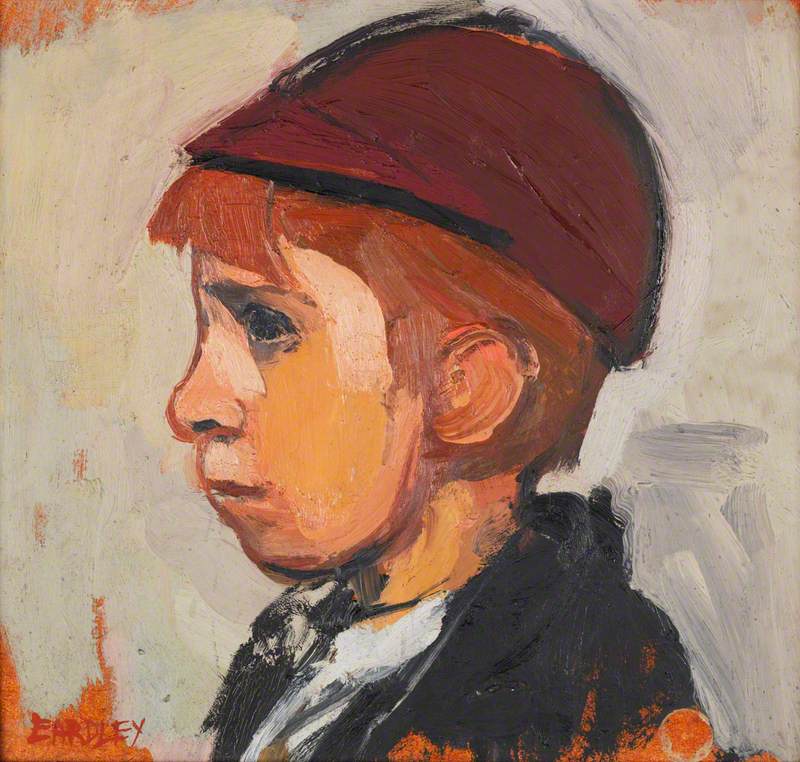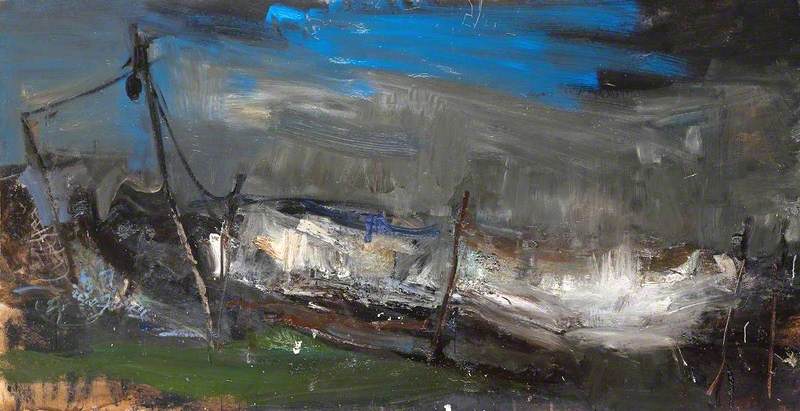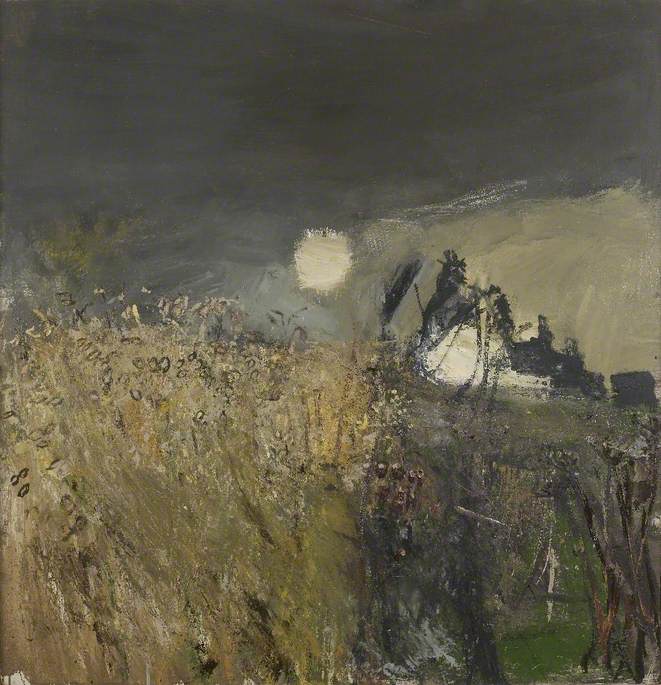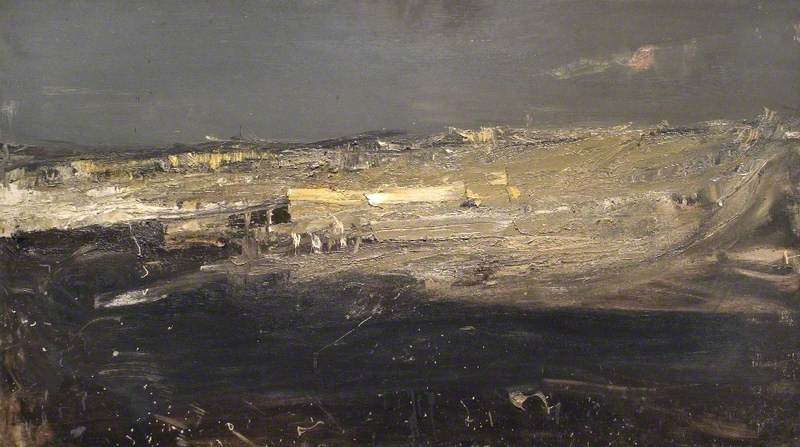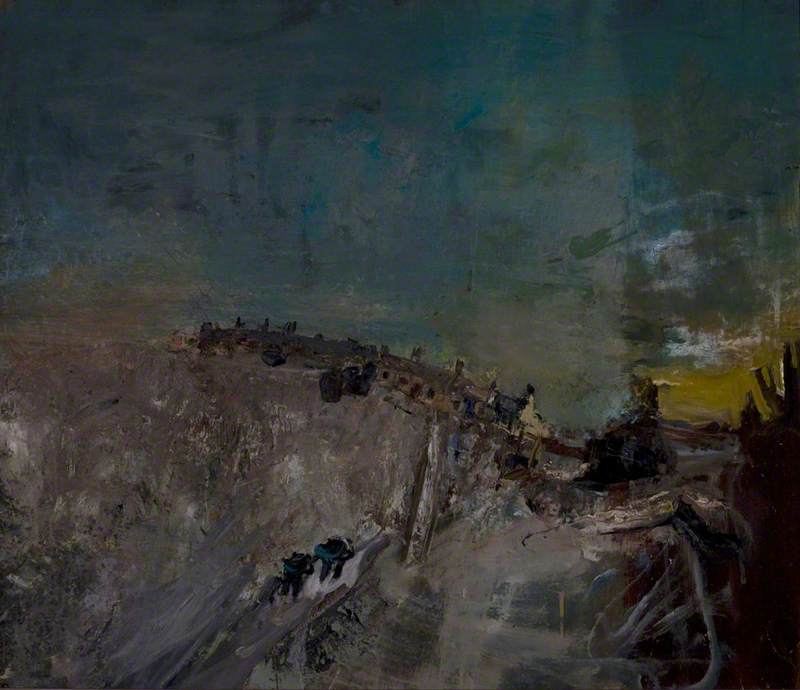To mark the centenary of Joan Eardley's birth, this curation looks at one work in each of the 36 UK public collections in which she is represented, from the Highlands to Hampshire. Eardley was born in Sussex and moved to Scotland in 1940. She trained at the Glasgow School of Art and Hospitalfield College of Art, Arbroath. She is renowned for her portrayal of the Townhead district of Glasgow - in particular of its children - and of Catterline, a fishing village on the Scottish north-east coast, which she painted in all seasons and in all weather conditions. The text has been provided by the collection curators and has been edited by Alice Strang. For details about the Eardley Centenary celebrations please see https://joaneardley.com/.
-
Inverness Museum & Art Gallery (High Life Highland)
Salmon Nets on the ShoreThis is the most northerly Eardley in a UK public collection. It shows the view looking south from the Makin Green in Catterline, with the lighthouse obscured in the distance. It was exhibited in Eardley’s 1961 solo exhibition at The Scottish Gallery, Edinburgh and was purchased that year by the Scottish Arts Council. It was one of 22 works which the Council presented to Inverness Museum & Art Gallery in 1997 when its collection was dispersed. All rights of salmon fishing in Scotland are private, heritable titles. During Eardley’s time in Catterline the rights were owned by Joseph Johnston & Sons of Montrose and the fishermen drying their nets on the shore would have been a familiar sight to her.
Joan Kathleen Harding Eardley (1921–1963)
Oil on board
H 96 x W 122 cm
Highland Council
-
University of Aberdeen
Salmon Nets on the Shore 1961Eardley made this version of Salmon Nets on the Shore in 1961, looking south from the west of Catterline’s pier. She was often drawn to the nets hanging out to dry on the Makin Green beside the sea. Salmon fishing continued in the village until the retirement of the last salmon fisherman in 1975. This painting was one of 11 modern Scottish works bequeathed to the University of Aberdeen by the poet and writer Eric Linklater (1899-1974) in 1974. He had been a student at the University and served as its Rector between 1945 and 1948.
Joan Kathleen Harding Eardley (1921–1963)
Oil on canvas
H 52 x W 73 cm
University of Aberdeen
-
Aberdeen Archives, Gallery & Museums
High Tide, a Winter Afternoon 1961Eardley’s first exhibition in Aberdeen was held at the Gaumont Cinema Gallery in 1951; this led to her first visit to nearby Catterline. The village became a new stimulus where she could depict the immensities of nature in the open air, painting and sketching 'on the spot'. High Tide, a Winter Afternoon was purchased by Aberdeen Art Gallery in 1969 and was one of her last, large seascape paintings. The blue boat in the foreground, numbered A471, was called The Linfall and belonged to local fisherman Harry Wylie. Aberdeen has collected Eardley's work since 1956 and was given a significant number of her works on paper by her sister, Pat Black, in 1987.
Joan Kathleen Harding Eardley (1921–1963)
Oil on hardboard
H 117 x W 235.7 cm
Aberdeen Art Gallery & Museums
-
The Argyll Collection, Argyll and Bute (Argyll & Bute Council)
Little Girl with a Piece 1959Little Girl with a Piece is part of The Argyll Collection, a learning resource for the young people of Argyll and Bute. The collection is exhibited in schools and libraries across Argyll and this painting is currently on display in Campbeltown Grammar School. Eardley’s portrait is of a young girl, sitting in the street with a sandwich, or 'piece', whilst reading a comic. Author and activist Naomi Mitchison (1897-1999) and Art Advisor Jim Tyre acquired the work for the collection in 1964. It will be the centre piece of a creative heritage placement in 2021, enabling public access to the painting at Dunoon Burgh Hall in April 2022.
Joan Kathleen Harding Eardley (1921–1963)
Oil on canvas
H 92.2 x W 72.1 cm
Argyll and Bute Council
-
Dundee Art Galleries & Museums Collection (Dundee City Council)
Green and Blue Boats 1963This late winter seascape captures the wild weather, with ominous grey sky and huge crashing waves, of the shore at Catterline. The boats, with their ‘A’ Aberdeen registrations, anchor the composition. Between them is a fisherman in blue. The dripping green boat paint was taken from the tin he was using and harks back to Eardley’s war work camouflaging boat hulls at a shipyard in Glasgow in 1944. In an interview of 1961, Eardley described north-east Scotland thus: “It's just vast waves, vast seas, vast areas of cliff. Well you've just got to paint it." Green and Blue Boats was acquired by the city of Dundee in 1964. It has been shown regularly at The McManus, Dundee’s art gallery and museum, ever since.
Joan Kathleen Harding Eardley (1921–1963)
Oil on board
H 120 x W 123.5 cm
Dundee Art Galleries and Museums Collection (Dundee City Council)
-
University of Dundee Fine Art Collections
Snow II c.1961Snow II was purchased by Queen’s College, Dundee (now the University of Dundee) from The Scottish Gallery, Edinburgh in 1961 for £65. The previous year, former student James Lamb, by then an engineer and the owner of Lamb’s Garage in Dundee, had gifted £1,000 to the university to start a Fine Art Purchasing Fund. A committee was formed mainly consisting of members not from the arts, but from medicine and dentistry, including the Professor of Psychiatry Ivor Batchelor, the Professor of Pathology A C Lendrum and the Professor of Dental Surgery N B B Symons. They decided to collect works by major Scottish artists of the past 200 years and this painting was the first purchase they made following Lamb's donation.
Joan Kathleen Harding Eardley (1921–1963)
Oil on board
H 78 x W 99 cm
University of Dundee Fine Art Collections
-
Perth Museum & Art Gallery (Perth & Kinross Council)
The Fireplace c.1955Eardley painted a number of domestic interiors that were typical of the working-class neighbourhood of Townhead. These works offer a glimpse into a world that was slowly disappearing. In the 1960s most of the area's buildings and roads were demolished as part of the Clyde Valley Regional Plan. Eardley first took a studio near Townhead in 1949 and found the area immensely stimulating, providing a rich source of inspiration. Eardley captured the area with sensitivity, not sentimentality, giving a sense of dignity to the residents and how they lived. She painted Children Playing on the other side of this canvas, which was accepted by HM Government in lieu of inheritance tax and allocated to Perth Museum & Art Gallery in 2010.
Joan Kathleen Harding Eardley (1921–1963)
Oil on canvas
H 88.9 x W 71.1 cm
Perth & Kinross Council
-
University of Stirling
Wave Study II 1958In 1954 Eardley began to rent the small cottage, No. 1 South Row, the most southerly dwelling in Catterline. It overlooks the bay, meaning that the sea was a constant presence and could be observed in all weathers and lighting conditions. Eardley's house is just visible in the distant right of Wave Study II. It is a tremendously powerful evocation of stormy weather, with waves whipped up as sunlight begins to break through the clouds. The energetic application of oil on board, in a variety of manners, shows it was created at speed. This is the only work by Eardley in the University of Stirling Art Collection. Like Inverness's painting, it was part of the Scottish Arts Council Collection Bequest and was accessioned in 1998.
Joan Kathleen Harding Eardley (1921–1963)
Oil on board
H 56 x W 89.9 cm
University of Stirling
-
Kirkcaldy Galleries
Breaking WaveBreaking Wave was made on Catterline's shore during a storm and used to belong to the author Naomi Mitchison. Eardley's expressive style captures the power of the sea and the ferocity of the wind. The dark angry sky, the white surf driving to shore, the fishing gear and creels blown against the sea wall are all depicted. You can almost taste the salt spray and feel the biting cold on your face, much as the artist herself would have, as she stood, board lashed down with ropes and large stones, brush or palette knife in hand, facing down the elements. Grains of sand and pieces of grit are stuck to the surface, adding to its sense of immediacy. It was purchased by Kirkcaldy in 1973 with assistance from the Local Museums Purchase Fund.
Joan Kathleen Harding Eardley (1921–1963)
Oil on board
H 124.5 x W 143 cm
Fife Council
-
Royal Scottish Academy of Art & Architecture, Edinburgh
A Field by the Sea – Summer c.1962In 1955 Eardley was elected an Associate of the Royal Scottish Academy (RSA) in Edinburgh. The RSA awards she received in the late 1940s and the purchase of her drawing Corrie, Arran for the Academy's collection in 1950, were early recognition of Eardley’s talent. She began exhibiting at the RSA Annual Exhibition in 1943 and in 1962 the joyous Catterline landscape A Field by the Sea - Summer was also purchased. Eardley was elected a full Academician in 1963, but died shortly afterwards. She had not been able to deposit a 'Diploma Work' with the Academy, which is a condition of membership, before her death. Fortunately, her family posthumously presented the companion work Summer Sea to the RSA in 1964.
Joan Kathleen Harding Eardley (1921–1963)
Oil on board
H 91.4 x W 101.6 cm
Royal Scottish Academy of Art & Architecture
-
Scottish National Gallery of Modern Art, Edinburgh (National Galleries of Scotland)
Sleeping Nude 1955Eardley met the former soldier, artist and joiner Angus Neil (1924-92) whilst studying at Hospitalfield College of Art, Arbroath and they became longstanding friends. This painting of him caused a controversy when it was included in the Society of Scottish Artists’ exhibition, held in Edinburgh in 1955. The fact that a female painter had depicted a male nude not only reversed art historical norms, but also offended those that felt such subject matter was not suitable for a woman artist. Neil's bleak surroundings and slim figure drew comparisons with the victims of World War Two concentration camps. The painting was presented to the Scottish National Gallery of Modern Art by Eardley's mother in 1964.
Joan Kathleen Harding Eardley (1921–1963)
Oil on canvas
H 76 x W 155.2 cm
National Galleries of Scotland
-
Museums & Galleries, Edinburgh
Farmhouse Stove c.1950Farmhouse Stove is one of the earliest works in this curation. It is an intimate interior scene centred around a kitchen range, the focal point of most domestic activity. A barefoot man is caught adjusting his shirt, whilst a companion sits nearby and laundry hangs above them to dry. Neither figure acknowledges the presence of the artist, who uses a high-toned palette and an emphasis on surface pattern which was to give way to more earthy hues and an increasingly expressive technique later in her career. This work was presented to Museums and Galleries, Edinburgh by the Scottish Arts Council in 1997.
Joan Kathleen Harding Eardley (1921–1963)
Oil on canvas
H 95 x W 73 cm
Museums & Galleries Edinburgh – City of Edinburgh Council
-
University of Edinburgh
Back Street Bookie 1952Eardley rented her first studio in Townhead, Glasgow in 1952. The area, of mixed residential and light industrial use, was overcrowded and dilapidated. However, Eardley was drawn to its vibrancy and closeknit community. She was a regular sight in the streets, sketching buildings, people and scenes of daily life in chalks and pastels, which she then worked up into paintings in the studio. Back Street Bookie is one such scene, in which a girl - perhaps stationed as a look out - leans away from a group of cap-wearing men, who are clustered around an illegal bookmaker. Ubiquitous washing is hung out of the window above them. This painting was purchased by the University of Edinburgh in 1966.
Joan Kathleen Harding Eardley (1921–1963)
Oil on canvas
H 107.5 x W 59.5 cm
University of Edinburgh
-
Lillie Art Gallery, Milngavie
Flood Tide 1962Flood Tide is one of the most popular paintings in Lillie Art Gallery's collection. Eardley has literally captured her stormy environment by painting outdoors in Catterline in changing weather, where hints of perhaps salt and sand are held in the paint adding to the texture and drama of the scene. Linked to East Dunbartonshire through her time living in Bearsden, from 1940 as a student and during early adulthood, Eardley exhibited with the Milngavie Art Club at the Lillie in 1962 and 1963. It was the wish of the artist's mother, Mrs Irene Eardley, that after her death the Gallery receive a work of significance by her daughter. As a result, Flood Tide was kindly gifted in 1982 by Eardley's sister, Mrs Pat Black.
Joan Kathleen Harding Eardley (1921–1963)
Oil on board
H 120 x W 183 cm
East Dunbartonshire Council
-
Hunterian Art Gallery, University of Glasgow
Sweetshop, Rotten Row 1957–1961Sweetshop, Rotten Row was purchased by Scotland's first National Poet Edwin Morgan (1920-2010) in 1961, shortly after it was painted. Measuring just 26 x 15cm, its surface is loaded with thick layers of paint as if Eardley wished to convey a physical sense of the surfaces she was encountering. It once hung in Morgan's flat in Anniesland, Glasgow and was one of four works which he presented to The Hunterian in 2004, where it joined another 40 works or so by the artist. It inspired his poem 'To Joan Eardley', which was published in 1968 and which begins 'Pale yellow letters / humbly straggling across / the once brilliant red / of a broken shop-face / CONFECTIO / and a blur of children / at their games, passing...'.
Joan Kathleen Harding Eardley (1921–1963)
Oil on board
H 26 x W 15 cm
The Hunterian, University of Glasgow
-
Kelvingrove Art Gallery & Museum, Glasgow (Glasgow Museums)
Glasgow Kids, a Saturday Matinée Picture Queue c.1949This work was painted soon after Eardley returned to Glasgow in 1949 after travel scholarships to Italy and France. She rented a studio at 21 Cochrane Street in the city centre and made drawings of local children in nearby Townhead. Glasgow was known then as 'Cinema City' and Eardley shows the neon lights reflected in the faces of the children as they queue to watch a film. The simplified freize-like arrangement of figures and shallow restricted space recalls early Renaissance frescoes that Eardley admired in Italy. Glasgow Museums holds 24 Eardley works (oils, pastels, watercolours and drawings) in its collection, including 10 studies for this painting. Glasgow Kids was presented by the Trustees of the Hamilton Bequest in 1966.
Joan Kathleen Harding Eardley (1921–1963)
Oil on canvas
H 70.8 x W 114.5 cm
Glasgow Life Museums
-
The Glasgow School of Art
CatterlineThis work, made in about 1958, was painted on the cliff edge looking northwards over the bay at Catterline. Thickly applied blocks of earthy colour create a striking and patchworked headland where the village’s pier, a cluster of fishing boats, and a number of small buildings can be picked out against the landscape. The rest of the canvas is devoted to an expanse of greys, blues and greens, depicting the sea and sky which merge together and surround the small village. This work was sadly lost in the Mackintosh Building Fire at The Glasgow School of Art (GSA) in 2014. However, a digital surrogate is available to view on Art UK and GSA’s websites, and the School still holds 24 of Eardley’s works on paper.
Joan Kathleen Harding Eardley (1921–1963)
Oil on canvas
H 88.2 x W 104 cm
The Glasgow School of Art
-
BBC Scotland, Glasgow
Study for Glasgow Back Street Children 1960Eardley was drawn to the games, squabbles and other interactions between the children who spent much of their time outside in Townhead. Study for Glasgow Back Street Children is in the landscape format she often used to depict street scenes rich with narrative. Children of varying ages, from sitting in prams to older ones locked in conspiratorial conversation, are sketched out across the composition. The graffiti-ed letters 'MG' occur in several of Eardley's works. Blocks of bright red and blue hint at what might have been developed in the painting for which this is a study. This work was given to the BBC by its tenth Director General, Alistair Milne (1930-2013) and it hangs at BBC Scotland's headquarters in Glasgow.
Joan Kathleen Harding Eardley (1921–1963)
Oil on canvas
H 72.5 x W 112 cm
BBC
-
Paisley Museum & Art Galleries (Renfrewshire Council Collections)
Boy on StoolPaisley Town Council first purchased Eardley's work in the 1960s shortly after her death. The active collecting of Eardley signified a change in Paisley’s collecting policy, then felt to be lacking in its representation of contemporary Scottish painting, driven by curator Cyril Rock. Boy on Stool depicts Iain MacKenzie who attended school in Townhead and gifted Eardley a drawing (visible in the background of the work). MacKenzie met Glasgow documentary photographer Oscar Marzaroli (1933-1988) through Eardley. This work was purchased from The Scottish Gallery around 1964, with a 50% grant approved by the Royal Scottish Museum. Renfrewshire Leisure holds one other oil and 10 works on paper by Eardley, as well as a playpen she decorated.
Joan Kathleen Harding Eardley (1921–1963)
Oil on canvas
H 91 x W 59 cm
Paisley Museum and Art Galleries, Renfrewshire Council Collections
-
National Trust for Scotland, Culzean Castle, Garden and Country Park, Maybole
Village, Evening, CatterlineVillage, Evening, Catterline and its companion piece Summer Landscape, Catterline are two of the 33 modern Scottish paintings given to the National Trust for Scotland by the Kirkcaldy businessman J. Douglas Hutchison. He is related to the artist William Oliphant Hutchison (1889-1970) and was inspired to start collecting by lunchtime visits to Kirkcaldy Art Gallery. His two works by Eardley now hang in Culzean Castle in Maybole, Ayrshire. This painting is a serene depiction of most of the houses in Catterline, viewed from the bay and looking north-west, including no. 18 which Eardley bought in 1959. The modest homes nestle harmoniously into their low-lying surroundings in an image realised in thick, creamy paint.
Joan Kathleen Harding Eardley (1921–1963)
Oil on hardboard
H 10.8 x W 45.1 cm
National Trust for Scotland, Culzean Castle, Garden & Country Park
-
Gracefield Arts Centre, Dumfries (Dumfries & Galloway Council)
The Clipping, 1955In 1955 Eardley was invited by the photographer Audrey Walker (1910-96) to stay at her family’s holiday home, Caverslee Farm Cottage, near Selkirk in the Scottish Borders. The area lacked the extreme physical conditions of Catterline, however, it did provide a landscape whose people and lifestyle intrigued Eardley. She had an inquisitive interest in the day-to-day activities of the farm, such as the sheep shearing and dipping. The annual sheep gathering-in and shearing was of particular interest and she undertook several hectic studies of the men at work wrestling with the sheep, culminating in The Clipping. This work is on loan to Gracefield Arts Centre in Dumfries from the Walker Family.
Joan Kathleen Harding Eardley (1921–1963)
Oil on canvas
H 30.6 x W 94.3 cm
Dumfries and Galloway Council
-
Abbot Hall, Kendal
Children and Chalked Wall No. 2 1963Children and Chalked Wall No.2 was a very early acquisition by Abbot Hall, which opened in 1962 and purchased this painting in 1963, shortly after it was made and not long before Eardley’s death. It comes from a celebrated series that Eardley began in the early 1960s, depicting two children standing against a richly graffitied wall below her studio on St James Road in Townhead. The sitters were members of the local Samson family, who regularly posed for Eardley in return for biscuits and other treats; sweet wrappers often made their way into the paintings, as in this work. The chalked wall behind is evidence of the girls’ activities, becoming an extension of themselves and showing how they are inextricably linked to their environment.
Joan Kathleen Harding Eardley (1921–1963)
Oil on canvas
H 80.5 x W 86 cm
Lakeland Arts
-
University of York
Sea and Snow 1958Sea and Snow of 1958 is an early example of a winter Catterline seascape. It was acquired by the University of York in 1964 with the aid of the Granada Art Fund, linked to Granada Television, whose Director Sydney Bernstein sat on the Fund’s committee. This was active from the University’s founding in 1963 until 1970 and had £500 a year to spent on contemporary art. The work’s tumultuous scene and tactile surface are evocative of the harsh weather Eardley endured whilst painting outdoors. It has been included in the virtual student-led exhibition Printed in Time: Three Centuries of Challenging Tradition which explores works in the University's collection by female makers, accessible at https://hoa-exhibition.hosted.york.ac.uk/2020-21/.
Joan Kathleen Harding Eardley (1921–1963)
Oil on canvas
H 96 x W 121 cm
The University of York
-
Huddersfield Art Gallery (Kirklees Musuems & Galleries)
Children and Chalked Wall No. 4Children and Chalked Wall No. 4 was purchased from Eardley's last lifetime solo exhibition, held at Roland, Browse and Delbanco, London in 1963. The purchase was led by Philip James of the Arts Council and Museums Association, in his capacity as Curatorial Advisor to Huddersfield Art Gallery. In a letter in the Gallery's archive he wrote: “I have today bought a picture for you by Joan Eardley. Although the show is only a week old practically everything has gone – purchases made by the Arts Council, Contemporary Art Society, Birmingham, Nat. Gallery of Modern Art, Edinburgh and Kendal, Abbot Hall. I have bought no. 13 in the catalogue. The price was 175 guineas and have got it for 150.” It is related to Abbot Hall's painting.
Joan Kathleen Harding Eardley (1921–1963)
Oil & collage on board
H 60.5 x W 74 cm
Kirklees Museums and Galleries
-
Birmingham Museums Trust
Winter Sun No. 1 1961–1962Winter Sun No. 1 was purchased for Birmingham’s collection from Eardley's London dealers, Roland, Browse & Delbanco, in 1963, a time of ambitious development for the city’s collection of modern painting. It is a vigorous example of Eardley's spontaneous, highly physical technique and depicts the wind-blown coastline of Catterline, looking north-west over the bay. The line of fishing equipment or laundry hung out to dry is mirrored in the cottages which progress along the lie of the land in the distance. The whole image is illuminated by the weak, low sun which emerges through the clouds. Using thick almost gritty paint, contrasting colours and perspectives, it captures the drama of the elements as well as the mundanity of human life.
Joan Kathleen Harding Eardley (1921–1963)
Oil on canvas
H 121.9 x W 130.8 cm
Birmingham Museums Trust
-
Herbert Art Gallery & Museum, Coventry
Archie Lafferty, Aged 6 c.1953The subject of this painting, Archie Lafferty, lived near to Eardley's Townhead studio. It is a successful character study of a young boy. The figure is seen head on, his face half in shadow. His pose, with ankles crossed and hands clasped, gives an impression of contained nervous energy. Indeed, in 1954 Eardley declared: 'Some of the children living in the district used to watch me at work. I thought it would be a good idea to paint them. There was only one difficulty - if they didn't sit still I couldn't paint them.' In 1988, Lafferty introduced himself to staff at the Herbert Art Gallery in Coventry, during an exhibition of Eardley's work. His portrait was purchased for the collection in 1965.
Joan Kathleen Harding Eardley (1921–1963)
Oil on canvas
H 61 x W 41 cm
Herbert Art Gallery & Museum
-
Alfred East Art Gallery, Kettering
The Sea, Winter II 1962 (?)This painting is perhaps best described in the artist’s own words from 1958: “Certainly the coldest and worst day of the year - a most exciting day, too, with every variation of colour – black sea, bright green-striped sea, brown sea, yellow sea...extraordinary strong cloud formations too.” The turbulent impasto of paint on the picture surface conveys the dramatic force and energy of stormy winter seas battering the Scottish coast. The painting is so passionate as to be barely figurative. It was donated to the Alfred East Art Gallery in Kettering in 1962 by the Contemporary Art Society. It was previously dated to 1962, but as the Society purchased it in 1959, it must have been created earlier than first thought.
Joan Kathleen Harding Eardley (1921–1963)
Oil on board
H 86 x W 154 cm
Alfred East Art Gallery Permanent Collection
-
Rugby Art Gallery & Museum Art Collections
Sunset 1960sEardley rarely dated her paintings. However Sunset is thought to have been made in about 1957. The palette based on browns and oranges reveals the inspiration she found in the work of the artist William MacTaggart (1835-1910). ¬Sunset comes from a series of works Eardley made in the fields surrounding Catterline. Sometimes she applied grasses onto her field paintings and the textured areas in the lower part of this work suggest indentations made by that method. In 1958 she described a setting sun as being 'as red as I wanted' and the warmth of its glow in this work contrasts with the harsh, weak light of her winter images. This painting was acquired by Rugby Borough Council in 1968 from Roland, Browse and Delbanco, London.
Joan Kathleen Harding Eardley (1921–1963)
Oil on board
H 47.5 x W 43.5 cm
Rugby Art Gallery and Museum Art Collections
-
Trinity College, University of Oxford
Townhead Close c.1955This painting was bought for £26 in 1955 by an enterprising group of students who ran an art collective in Trinity College, Oxford. Members' subscriptions were invested in modern paintings and prints which they swapped between their rooms each term. Originally known as Girls by the Door, The Gorbals, Townhead Close has been proposed as an alternative title, given what we know of Eardley's practice. The work currently hangs in the room of a tutor. We love the painting for its warmth and vibrancy, its honesty and expressiveness, and for the fact that it's so different from the classical landscapes and formal portraits that are found elsewhere in the College. It brings a slice of urban Glasgow into the centre of an Oxford college.
Joan Kathleen Harding Eardley (1921–1963)
Oil on canvas
H 54.5 x W 48 cm
Trinity College, University of Oxford
-
Government Art Collection, London
Boy's HeadIn an interview of 1963 describing how children became the focus of her work, Eardley recalled: "[they] usually come up and say ‘will you paint me?’… It’s not usually possible to get a child to sit still, so mostly I just watch them moving about and do the best I can." Eardley first noticed the sitter in this portrait while walking in Townhead, pushing her paints and easels around in an old pram. Sandy Samson, along with his 11 siblings, lived in a tenement situated a short walk from the artist’s studio and frequently sat for her in the 1950s and 60s. In this carefully observed portrait, he is depicted in profile, wearing a red hat and displaying a pensive gaze. It was purchased for the Government Art Collection in 1954.
Joan Kathleen Harding Eardley (1921–1963)
Oil on board
H 25.5 x W 27.5 cm
Government Art Collection
-
The Fleming Collection, London
Rag and Bone Shop, Glasgow mid-20th CEardley’s Rag and Bone Shop is one of five paintings to have been acquired by the Fleming Collection in our fifty or so years of collecting. An expressive and characterful painting, it has a high viewpoint and shows Eardley's artistic interest in the unglamorous subject of a 'rag and bone' shop selling second-hand goods. This gouache was bought from Bourne Fine Art in Edinburgh in 1988, to hang on the office walls of the Robert Fleming & Co bank and to promote the firm's Scottish roots. It has since been exhibited numerous times in London and was lent to the National Galleries of Scotland Eardley retrospective in 2007, as well as to other exhibitions across the country.
Joan Kathleen Harding Eardley (1921–1963)
Gouache
H 33 x W 26.5 cm
The Fleming Collection
-
Tate Britain, London
Salmon Net Posts c.1961–62Eardley drew, painted and photographed the salmon nets used by the fishermen of Catterline in earnest from about 1956. The posts referred to in this work's title are the tall larch poles between which the salmon bag nets were strung up to dry after use. They were situated on the Makin Green throughout the fishing season and it was here that Eardley's ashes were scattered following her death in 1963. Salmon Net Posts is a monumental example of Eardley's Catterline paintings and measures 119 x 218cm. It was presented by the Friends of the Tate Gallery to the collection in 1986.
Joan Kathleen Harding Eardley (1921–1963)
Oil on board
H 118.5 x W 217.5 cm
Tate
-
Arts Council Collection, London
A Field of Oats 1962A Field of Oats shows the sun through haar, above a late summer cornfield. It is one of a series of works depicting the fields around Catterline, in this case from the south side of Eardley's cottage at No. 1 South Row, whose gable end is visible on the right. Eardley described it in 1962 as "a handy spot as no-one comes near and I can work away undisturbed. I just go on from one painting to another – just the grasses and the corn – it’s oats this year, barley it was last year. But every day and every week it looks a bit different...I just leave my painting table out there and my easel and palette." Arts Council Collection acquired this work in 1963 and it has been shown regularly in exhibitions across the country.
Joan Kathleen Harding Eardley (1921–1963)
Oil on board
H 100.2 x W 96.7 cm
Arts Council Collection, Southbank Centre
-
Southwark Council and South London Gallery, London
Winter Landscape 1954This is the sole work by Eardley in Southwark’s art collection in London. It is thought to have been acquired by South London Gallery shortly after it was painted, from the 1955 exhibition Contemporary Scottish Painting staged at the Art Exhibitions Bureau, London. An early Catterline work, it was painted in the northern part of the village. The backs of the quartet of houses at no.s 19-22 can be seen, as well as 'Sarah's Cottage', part of a more northerly row, on the far right. Between 1952 and 1954, Eardley stayed in the nearby Watch House, known as 'The Watchie', before she rented No. 1 South Row at the other end of Catterline.
Joan Kathleen Harding Eardley (1921–1963)
Oil on canvas
H 66 x W 96.5 cm
Southwark Art Collection
-
Reading Museum
Coastline at Catterline, Stonehaven, KincardineshireBesides its dramatic subject matter, the grains of sand and other beach detritus caught in the surface of this work reveal that it was painted on the beach at Catterline in stormy weather. Drips and strokes of paint appear to have been whipped across the large board (102 x 181cm) by the wind, as the artist battled with nature whilst creating a painting which reverberates with energy and vitality. It was purchased by Reading Borough Council in 1967 with the assistance of the Victoria & Albert Museum Purchase Grant Fund, when the collecting policy for Reading Museum had been extended from important British paintings made between the wars, to include contemporary British art.
Joan Kathleen Harding Eardley (1921–1963)
Oil on board
H 102 x W 181 cm
Reading Museum
-
National Trust, Mottisfont Abbey, Romsey
Catterline in Winter c.1960/1967Catterline in Winter is the most southerly Eardley in a UK public collection. It is one of three works by her which the artist Derek Hill (1916-2000) presented to the National Trust in 1996, for display at Mottisfont Abbey in Romsey. Hill had been friends with the Abbey's former owner, the art patron Maud Russell (1891–1982) and deeply admired Eardley's work. In a tribute he wrote about Eardley for Apollo magazine in 1964, he stated:"No one before her had observed the things and the places she painted more clearly than she did." In this work the houses of South Row appear like a boat pitching on a stormy sea, but the foreground is in fact a field bisected by a path on which two walkers brace against the winter wind.
Joan Kathleen Harding Eardley (1921–1963)
Oil on board
H 25 x W 21 cm
National Trust, Mottisfont Abbey




